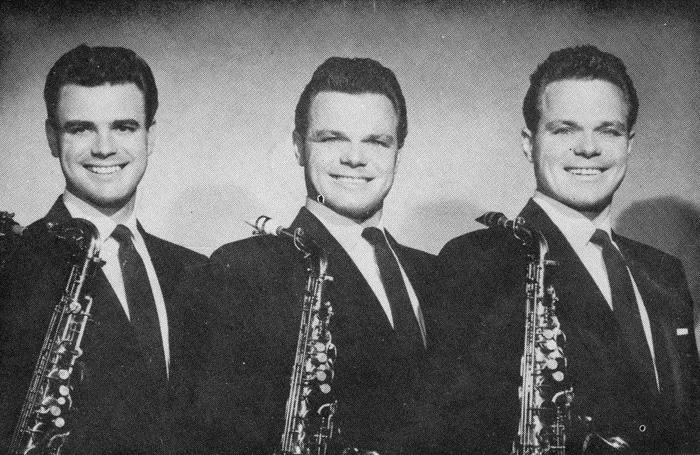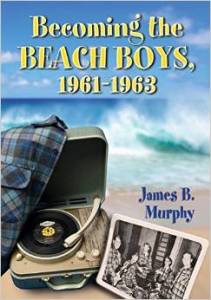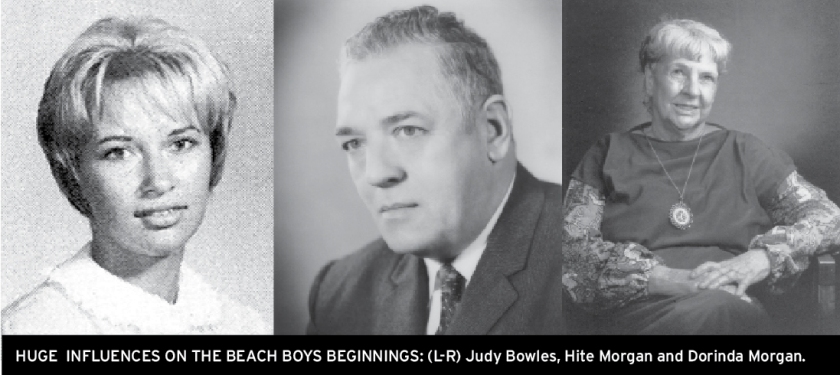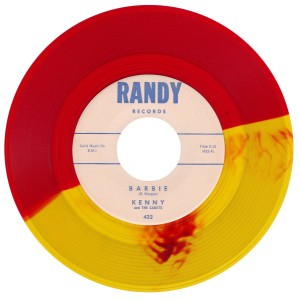Goldmine Magazine Interview by Ken Sharp
All images courtesy of James B. Murphy

From performing in school cafeterias to tearing it up on the stage of the Hollywood Bowl, James B. Murphy’s book, “Becoming the Beach Boys 1961-1963” chronicles the back story behind how it all happened in exhaustive detail. Culling original and archival interviews, newly discovered documents and illustrated with scores of previously unseen photographs and ephemera, the book is a marvel of research teeming with revelatory information about the group’s formative years, puncturing myths and setting the record straight about this seminal period in the group’s history.
Goldmine: Hite and Dorinda Morgan are key movers and shakers in the band’s early career. Tell us about them and their importance to the group’s career arc.
James B. Murphy: Hite and Dorinda Morgan, a husband and wife songwriting team in their late 40s, were friends of Audree and Murry Wilson for a decade before the Wilson brothers decided they wanted to make a record. The Morgans recorded aspiring artists in a make-shift recording studio in their living room and produced the first nine recordings by the Beach Boys, including “Surfin’” and early versions of “Surfin’ Safari” and “Surfer Girl.” And yet, after 50 years, hundreds of magazine articles, more than a dozen books and several documentaries about the band, I knew very little about the Morgans and had never seen a photograph of them. When I first spoke with Bruce Morgan, their son, I told him I believed his parents were overlooked in the Beach Boys story and that one of my goals was to shed more light on their integral role in the band’s early history. Brian and the Boys went on to more sophisticated writing and production, but Hite and Dorinda Morgan were the first people in the L.A. music industry who believed in them. It seemed to me we should know more about them.
GM: Little is known about the background of Candix Records and its founders. Fill us in.
JM: Candix Enterprises Inc. released the Beach Boys first record. It was an independent record company founded August 26, 1960, in Fresno, California, by twin brothers Richard and Robert Dix, who enlisted the help of their younger brothers Albert and Sherman (a fifth brother, Theodore, and a sister, Sarita, were not involved). The Dix brothers were professional musicians and, for the previous two decades had toured the country as the Dix Brothers Orchestra. They hired William Silva Canaday for his knowledge of the L.A. music industry and the name of the record company was an amalgam of their last names (CAN from Canaday + DIX). The plan was for Sherman to funnel the profits from the brother’s real estate and home construction business in Fresno into the record company, but Sherman had other ideas. This resulted in a chronic shortage of capital, frustrating Joe Saraceno, their Artist and Repertoire director, and two record promoters who were always battling a shortage of records. In fall 1961, Hite Morgan, on the strength of a recommendation from Bill Angel, the record librarian at KFWB, brought the Beach Boys’ first record, “Surfin’,” to Candix. It was a great opportunity for Candix, whose biggest hit to date was The Frogmen’s “Underwater” that reached No. 44 in spring 1961, but it could not have come at a worse time. Bob Dix had discovered Saraceno diverted “Surfer’s Stomp,” a No. 31 hit by The Mar-kets, to his own recently formed Union Records. Saraceno resigned from Candix. Bob had also recently fired Silva and was pursuing legal action accusing him of embezzling $15,000 from Candix. Bob did everything he could (which I detail in the book) to keep “Surfin’” stocked in record stores nationwide. “Surfin’” reached No. 3 in L.A., but stalled at No. 75 in Billboard. It likely would have gone further had it been handled and promoted differently. In September 1963, Bob Dix chose not renew the company’s corporate status. He had released 41 singles on the Candix label, one (“Surfin’”) on his X Records subsidiary, and two on the Candix-distributed Storm label.

The Dix Brothers
GM: In the book, you follow the band playing house parties to the Hollywood Bowl in a short timespan. Take us through what shaped them as a live act.
JM: The key thing about the early Beach Boys in the studio and on stage is that only nine months after forming they were thrust into the national spotlight. Unlike The Beatles, who enjoyed a lengthy musical apprenticeship, honing their live skills and stockpiling songs, the Beach Boys scored a No. 3 regional hit with their first record, recorded a demo reel and landed a seven-year contract with Capitol Records. Their Capitol debut, “Surfin’ Safari” backed with “409,” was a double-sided hit and the pressure was on. Demand for their personal appearances skyrocketed. By most contemporary accounts, they were not a very good live band when they started. But they persevered and kept at it, propelled by Murry Wilson’s persistence and assertive personality. They played grand openings, record stores, hardware stores, appliance stores, birthday parties, gymnasiums, recreation centers, high schools, roof tops, back yards and parking lots. The hits just kept coming and, fueled by their songwriting and unparalleled vocals, they became one of the best and enduring live bands. For most concertgoers, seeing and hearing the Beach Boys live was an unforgettable experience.
GM: There are quotes in the book culled from members of bands that played on the same bill with the Beach Boys in the early days remarking they were not impressed with their performing abilities. When did they come into their own as a live act?
JM: The Beach Boys learned to play as a band in front of live audiences. Their first (April 24-May 5, 1963) and second (July 19-August 30, 1963) tours outside of California were hampered by the intermittent absence of Brian Wilson (Al Jardine was recruited to fill in for Brian on the road). Some early reviews are mixed, most likely because of Brian’s absence in the harmony stack. Brian grew tired of touring very early on and decided, quite wisely in retrospect, it would better serve the band if he stayed home to write, arrange and demo new material for the group. But when David Marks quit, Jardine was enlisted as a permanent replacement for Marks and Brian lost his road replacement and had to rejoin the touring band. Their October 19, 1963, performance at the 31st Annual Y-Day at the Hollywood Bowl is available online and that gives us a pretty good idea of how the Beach Boys, with Brian, sounded as a live band toward the end of 1963. They played “Little Deuce Coupe,” “In My Room,” “Be True to Your School,” “Surfer Girl” and an a cappella tribute to KFWB, the radio station that co-sponsored the show. These are solid, somewhat raw, but wildly exciting performances. Given the technological limits of recording a live show in an outdoor cavernous venue like the Hollywood Bowl, that they sound so powerful and exhilarating is quite remarkable.
GM: Murry Wilson, father of Brian, Dennis and Carl, and the band’s manager is a misunderstood figure in the band’s history. Were there new insights gleaned about his role and working methods?
JM: Let me first say I do not pretend to know what actually went on inside 3701 West 119th Street, Hawthorne, California, as Brian, Dennis and Carl Wilson were growing up with their parents, Audree and Murry. Only the Wilson boys fully experienced Murry’s strengths and shortcomings as a father. In fall 1961, Murry was 44 years old, owned his own leased machinery business, had three teenage sons, each two years apart, and the family lived in a two-bedroom, one-level home. On his modest salary, Murry provided Brian with accordion lessons, a record collection, a meeting with his musical idols, the Four Freshmen, a Wollensak tape recorder and a used 1957 Ford Fairlane for his senior year at Hawthorne High. Al Jardine recalled Brian was a natty dresser in high school, especially noting his stylish Florsheim loafers. Dennis had a motorized go-kart, a BB gun, a memorable 10th birthday party and a 9-foot surfboard. Carl had an acoustic-electric guitar, an amplifier and guitar lessons. Now, material possessions do not make a childhood happy, but Murry did his best to provide his boys with things they enjoyed. And no one fought harder for the fledgling Beach Boys than Murry. Key players in the early Beach Boys’ story like Chuck Britz, Stan Ross (co-owner of Gold Star studio), Russ Regan and Fred Vail are all on record with positive comments about Murry, crediting him with much of the group’s early success. Interestingly, most of the negative things the brothers said about their father came after he died from cardiac arrest on June 4, 1973. Nick Venet, the band’s first staff producer at Capitol, provided much anti-Murry fodder. But keep in mind, in summer 1963, after Murry told Capitol the Beach Boys refused to work with Venet, Nick was gone from Capitol within a few months. Now, before I am accused of being a Murry apologist, by many accounts he was a flawed man, haunted by his own rough childhood. Perhaps Murry’s greatest shortcoming was not recognizing the need to provide a more protective environment for Brian, a sensitive soul who, at the time, was doing everything, and not knowing when to step back and allow his sons the freedom to pursue their own creative vision. But without Murry there would have been no Beach Boys.
 GM: One of the many coups of your book was tracking down Judy Bowles, Brian Wilson’s girlfriend who inspired some of his music. Tell us about her, how you located her and characterize her place in Brian’s universe and her role as his muse.
GM: One of the many coups of your book was tracking down Judy Bowles, Brian Wilson’s girlfriend who inspired some of his music. Tell us about her, how you located her and characterize her place in Brian’s universe and her role as his muse.
JM: Judy Bowles was Brian Wilson’s first serious romantic relationship. Brian began dating Judy in summer 1961 just before the group formed. They dated during the formation of the band, the writing and recording of “Surfin’,” signing with Capitol Records, all of 1962 and most of 1963. Audree Wilson helped Brian select a diamond engagement ring that he presented to Judy for Christmas 1962. They planned to marry within the year. Judy was the inspiration for “Surfer Girl,” “Judy” and, after a painful break-up in fall 1963, “The Warmth of the Sun.” It took me a long time to find Judy, and I would not have been able to gain her trust and confidence without the help of a good friend of hers who, quite modestly, declined acknowledgement in the book. It was a real joy speaking with Judy – one of the highlights of researching the book. She told me I was the first writer who took the time to look for her and speak with her, and that nearly everything written previously about her was untrue. I found that astonishing. Judy was open, honest, funny, down-to-earth, grounded and had a wonderfully healthy perspective on that part of her life and how things worked out. She really loved Brian and he will always have a special place in her heart. After the success of “Love & Mercy,” I would like to see a film adaptation of their love story as Brian came into his musical gift, helped form the Beach Boys and the group experienced the ups and downs of worldwide fame.
GM: Cite the major revelations you were able to uncover that surprised you?
JM: The dates of September 15, 1961, for the “Surfin’” demo session, and October 3, 1961, for the “Surfin’” recording session, which have been accepted for the past 25 years, cannot be verified. That alters the entire chronology of certain key events, including the group’s rehearsal sessions, the demo session, when Al joined the group, the renting of musical gear, the recording session and when Hite Morgan shopped an acetate of “Surfin’” to record labels.
I believe “Surfin’” was written, a Standard Songwriter’s Contract with the Morgans signed and a demo recorded before Al joined the band. Then, after he runs into Brian on the campus of El Camino Community College, Al begins singing with the Wilson brothers and Mike. When Audree and Murry went to Mexico for a weekend, the guys rented musical gear, financed by Al’s mother, Virginia, in an effort to up their game. They continued rehearsing for about a month and then recorded the version of “Surfin’” released on Candix 331. Although “Surfin’” is credited to Brian and Mike, Carl contributed the guitar part and Dennis made some lyrical contributions that went uncredited.
As Murry suspected, the Beach Boys were indeed short-changed in royalties on the sales of “Surfin’.” They received $990, but should have received about $2,500.

GM: What are the major myths you’ve been able to solve while doing the book?
JM: Here are a few that come to mind: The rental of musical gear did not occur over the Labor Day weekend, September 2-4, 1961. And when Audree and Murry traveled to Mexico, they most certainly did not leave their sons $800, as one source noted, for food or an emergency.
The earliest footage of the Beach Boys singing live is their performance of “Surfin’ Safari” at the Azusa Teen Club on July 27, 1962, filmed for Dale Smallin’s documentary “One Man’s Challenge.” But the film crew did not just happen to show up on a night the band was performing. This was a scheduled taping and the group rehearsed for hours in the sweltering heat of the Azusa Recreation Center that doubled as the teen club.
“Surfin’” on Candix 331 was their first release. For reasons that I detail in the book, it was next released on X Records 301, Candix 301, the Era Records-distributed Candix 301. Also, an “Audition Only” copy was released on the Era Records-distributed Candix 301.
This is a minor myth, but when their first royalty check arrived in mid-April 1962, it was long believed Murry added $100 of his own money to bring it up to $1,000 so the five boys could each receive $200. But the royalty check was for $990, so Murry actually contributed $10.
GM: Are there still mysteries about that period of time that elude you that you’d like to uncover?
JM: A photograph of the Beach Boys with Al Jardine before David Marks replaced him has been reported to exist, but has never surfaced. Does anyone, especially the surviving members of the band, have such a photo? I would like this one further clarified. When did Al reconnect with Brian by the chance encounter of running into him on the campus of El Camino Community College where they were both enrolled in fall 1961? The school year began September 11, 1961, and the Standard Songwriter’s Contract for “Surfin’” was signed September 15, 1961. Brian’s handwritten list of the Pendletones as a quartet (the three Wilson brothers and Mike Love) is dated October 12, 1961. Hence, it may have been well into October before Al ran into Brian and began singing with the Wilson brothers and Mike. If that is true, as I believe it to be, then Al may have joined the band after the “Surfin’” demo was recorded, but before the recording session that yielded the version of “Surfin’” released on Candix 331.
Second, I wonder whether “Surfin’,” “Luau” and “Lavender” may have been recorded at Hite Morgan’s Stereo Masters, 5534-5538 Melrose Avenue, Los Angeles. That would mean there was only one session at World Pacific Studio, 8715 West Third Street, Los Angeles — the one on February 8, 1962, at which they recorded “Surfin’ Safari,” “Surfer Girl,” “Judy” and “Karate” (aka, “Beach Boy Stomp”). Both Bruce Morgan and Dino Lappas, the recording engineer at World Pacific, independently recalled only one session at World Pacific. Intriguing.
And third, I would like to discover additional personal appearances the band made in 1962, especially between January and June, and the mysterious mini-tour Murry booked in California around Christmas 1962.
 GM: Tell us about the Holy Grail most collectible Beach Boy records from that period and their value in 2015.
GM: Tell us about the Holy Grail most collectible Beach Boy records from that period and their value in 2015.
JM: The most collectible Beach Boys records from 1961-62 are the red and yellow splash wax of “Barbie” (b/w “What Is a Young Girl Made Of?,” Randy 422), the “Complete Selections from Surfin’ Safari by the Beach Boys” promotional EP with cardboard sleeve (Capitol PRO 2186), the “I Was There KFWB Day!” mailer sleeve that housed the promotional 45 “Spirit of America” (b/w “Boogie Woodie,” Capitol Custom) and “The Surfer Moon” (b/w “Humpty Dumpty,” Safari 101) by Bob and Sheri. As with most rare records, they’re worth whatever two people say they’re worth!
I would like to pose a question to Goldmine readers — has anyone ever seen and can anyone verify a white label promotional copy of “Surfin’” on Candix 331? [Not the black label “Audition Only” “Surfin’” on the Era Records-distributed Candix 301]. Candix produced white label promo records from Candix 303 through 330, but I have never seen a white label promo of “Surfin’” on Candix 331. I don’t think it exists, but I would like to be proven wrong. GM
On-line at: Goldmine article, January 27, 2016


Thanks for shariing
LikeLike